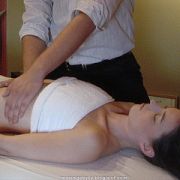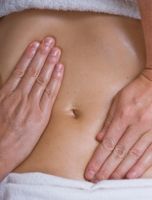Massage Remedies
Several common ailments such as headaches, severe migraines, asthma, IBS and Other Digestive Problems, Menstruation and Menopause problems, Cramps, Oedema, Thrombosis, strains and sprains, and even Insomnia and anxiety can be taken care of by regular and effective Massages. Massage therapy, if done by experts and regularly can relieve us by releasing our tension and stress and restoring our emotional and physical wellbeing thereby increasing our energy levels and rejuvenating us.

1. Sinusitis And Headaches:
Sinusitis: The sinuses are hollow, air-filled cavities that drain into the nasal cavities. Congestion or inflammation of the sinuses results in a heavy, blocked-up feeling and pain in the face and head. Self-massage is very effective because you can regulate the pressure according to the severity of the condition. Place your middle fingers on the sides of your nose, breathe in, and on the out breath glide your fingers down the sides of your nose to the nostrils and onto the cheeks, following the natural curve. Palpating the areas at the beginning and end of this sequence will also help to drain the sinuses.
Headache: A. Slowly place one hand with your fingers spread on your partner’s head and forehead. Placing your other hand on top, slowly lean your weight into your hands until a comfortable pressure is achieved, hold for about 15 seconds and then release without losing contact. This is a very subtle movement, but a headache in the forehead region can be relieved by this deep pressure. Repeat four to five times.
B. Place the pads of your fingers just along the underside of the brow bones. Taking care not to apply too much pressure, because this area of the face can be quite tender, hold for about 15 seconds and then release without losing contact with your partner. Repeat four to five times.
C. Move your hands to the sides of the head, with your thumbs positioned on the temples. Check with your partner that the pressure is comfortable and then slowly rotate the pads of your thumbs clockwise about 15 times – the slower the rotation, the more relaxing it will feel – then hold the pressure without rotating for about 15 seconds. Finish by bringing your hands down to cover both ears, wrapping your fingers underneath them and then drawing your fingers down and off.

2. Digestive Problems:
Our digestive processes tend to reflect our state of mind. Stress can cause all sorts of conditions in this area, including Irritable Bowel Syndrome, ulcers, indigestion, constipation and diarrhoea. This is because the blood supply is inhibited, and this, in turn, affects the way the digestive system absorbs and distributes nutrients. When massaging the abdomen, be aware that your partner may feel vulnerable, so take some time to observe their breathing pattern and try to coordinate your strokes with this. Even the lightest touch may cause her to contract her abdominal muscles instinctively. Before you start, pause for about 20 seconds to reassure your partner, lift off to apply oil and return gently, ready to start massaging.
A. Using effleurage, glide upward to just under the breast area and then, with your hands on either side of the torso, slowly return to your starting position. This stroke will calm and soothe the area and is particularly beneficial in relieving both abdominal bloating and indigestion. Repeat five times in a flowing movement.
B. Always apply this stroke after you have relaxed the area with step A. Using the flat of your hands and gentle pressure, on your partner’s out breath draw your hands apart diagonally (left ribs to right hip, for example), working outward in a sweeping action and remembering that this is more of a stretching movement than working deeply. This will help to release contracted muscle and so is excellent for menstrual cramping. Using a massage oil blended with chamomile, lavender or rose can provide additional relief. Repeat in the other direction.
C. Place one hand on top of the other and, making sure that your whole hand is in contact with your partner, work in a circular, clockwise movement from the solar plexus following the direction of the large intestine. Start with a large circle and continue, reducing the size of the circle but increasing the pressure, for a further four or five times. Remember to follow your partner’s breathing withing with your hands. You will find this movement helpful for relieving abdominal pain and constipation.

3. Irritable Bowel Syndrome(IBS):
This is a collective term for disorders of the bowel. Massage can be very effective in relaxing the area and so reducing spasm of the involuntary muscles.
A. After warming up the area with gentle effleurage, position yourself side-on to your partner and place your hands on opposite sides of the abdomen, cupped slightly over the sides of the torso. Using equal pressure and even weight on your palms and fingers, push one hand forward and the other back in a petrissage motion covering the whole of the abdomen from near side to far side.
B. Place your hands just below the left side of your partner’s ribcage, with your fingers spread and facing up toward her head. This is a vibrational technique: as you apply pressure with the pads of your fingers, make very small circular movements with each fingertip simultaneously. This massages the descending colon and helps to move its contents more smoothly along the digestive tract.